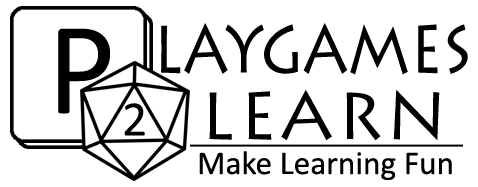Dice rolling competitions are quick, exciting games to play and are easy to define. They are also ideal for encouraging children to lead the play and make the rules. Best of all, from a learning point of view, you can embed a lot of math in them.

Flash! by Blue Orange Games
A dice rolling competition that we enjoyed early on is “Flash!” by Blue Orange Games. For us, this game introduced the basic math concepts of recognizing numbers, evens and odds, and sets and sequences. It also introduced the (sometimes extreme) frustration that probability is just a tendency towards an average and has nothing to do with “fairness”. 🙂
After introducing multi-sided game dice into our play, we were able to expand upon these basic concepts and grow the complexity of the math in the games we played; progressing through things like:
- Determining the greater / lesser of two numbers,
- Adding / subtracting
- Multiplying / dividing
- Negative numbers and remainders
- Primes and factors
- …and just for fun – Critical Hits! (and misses)
Most recently, we have used our multi-sided game dice to perform data generation for graphing / statistics and for use in increasingly complex formulas.
For example, one of the games that we have played was taking turns to see how many times we each had to roll a given multi-sided game dice in order to roll each of its numbers at least once. Do this for each of the six dice over ten iterations and you will roll a lot of dice! This gives you a lot of data for observing patterns and analyzing / graphing basic statistics, eg: averages / means, distribution curves, confidence intervals, and outliers.
We also made up a dice rolling competition we call “Target Zero”. In this math-centric game, players roll a predefined set or grouping of multi-sided game dice. Then, using any mathematical operators they can think of, players create a formula or equation that uses the numbers rolled to yield a solution as close to zero as possible. (For a more difficult challenge level of this same game and to encourage incorporation of the more advanced operators, limit the use of each operator to once only in a given equation.)
To give us the ability to have as many dice as we want, to be rough with them when excited, and to create custom values for our dice faces, we created our own templates and they are now freely available on our website. Our multi-sided game dice printables include both numbered and un-numbered templates – perfect whether you need a random-number-generator or if you need a “random-anything-generator”. 🙂
Join our Community of Parents and Educators!
At Silverpath Publishing / PlayGames2Learn.com, we believe in #LearningThroughPlay to help #MakeLearningFun. We publish fiction and educational tabletop games for children and young adults.
To receive announcements about new releases and promotional discounts as well as invitations to participate as beta-readers or play-testers, subscribe to our mailing list.
